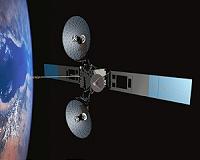 |
Toulouse, France (SPX) Mar 11, 2010 It is the "Swiss Army Knife" of satellites. COMS (Communications, Oceanography and Meteorology Satellite) is the first European 3-axis stabilised geostationary observation satellite to carry three payloads dedicated to meteorology applications, ocean observation and telecommunications. COMS carries a meteorology imager, an "ocean colour" payload and a Ka-band telecommunications payload.
Meteorology
Oceanography
Telecommunications The satellite left Toulouse today for the French Guiana Space Centre, from where it will be launched at the end of April. COMS was developed and manufactured by Astrium in cooperation with the Korea Aerospace Research Institute (KARI). Engineers initially worked together for 2 years in Toulouse. The work was then transferred to Daejeon, where the teams spent an additional 2 years assembling the satellite and testing it in KARI facilities. The satellite then made the return trip to Toulouse for finalisation before being sent to the launch pad. Jean Dauphin, Director of Earth Observation and Science for Astrium France, said: "All the tests performed on COMS have confirmed Astrium's ability to design and build 3-axis stabilised geostationary observation satellites that can be used for a variety of highly demanding applications. This represents a European first and Astrium employees can be proud of having achieved such a significant success. Astrium has met the challenge of integrating three separate meteorology, oceanography and telecommunication payloads on to the same satellite-three payloads that sometimes had conflicting requirements." The development of 3-axis stabilised geostationary satellites represents a major technological achievement, as they are considerably more powerful and can accommodate larger and more complex payloads. The new satellites will revolutionize Earth observation by making continuous space-borne monitoring a reality. Astrium has also successfully delivered the operational version of the image registration ground software. This software will provide South Korea with the next generation of image positioning, which is essential for meteorological models. With a take-off weight of 2.5 metric tons and an end-of-life on-board power level of 2.5 kW, the satellite will remain in service in a geostationary orbit for at least eight years. COMS re-uses some of the avionics of the Eurostar E3000 telecommunications satellites, adapting them for optical observation from a geostationary orbit. This achievement confirms Astrium as a key global player in the field of geostationary orbit observation satellites. This is demonstrated in terms of understanding the vital performance requirements for this type of mission, designing the corresponding on-board and ground systems and then building the satellite and optical payloads in response to these specific needs. COMS also solidifies Astrium's position as the world's leading exporter of Earth observation satellites.
Share This Article With Planet Earth
Related Links Astrium Space Technology News - Applications and Research
 NASA Launches Interactive Simulation Of Satellite Communications
NASA Launches Interactive Simulation Of Satellite CommunicationsMoffett Field CA (SPX) Mar 10, 2010 NASA has unveiled an interactive computer simulation that allows virtual explorers of all ages to dock the space shuttle at the International Space Station, experience a virtual trip to Mars or a lunar impact, and explore images of star formations taken by the Hubble Space Telescope. In an effort to excite young people about space and NASA's missions, the agency has launched the online Spa ... read more |
|
| The content herein, unless otherwise known to be public domain, are Copyright 1995-2010 - SpaceDaily. AFP and UPI Wire Stories are copyright Agence France-Presse and United Press International. ESA Portal Reports are copyright European Space Agency. All NASA sourced material is public domain. Additional copyrights may apply in whole or part to other bona fide parties. Advertising does not imply endorsement,agreement or approval of any opinions, statements or information provided by SpaceDaily on any Web page published or hosted by SpaceDaily. Privacy Statement |